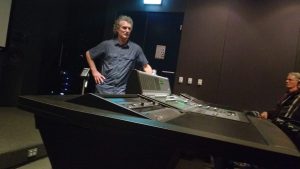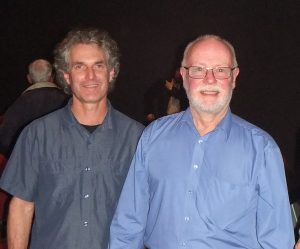Chairman Graeme Huon welcomed all to the meeting and introduced Andy Stewart, owner of The Mill studio in Gippsland to talk to us on his perspectives as a tracking, mixing and mastering engineer on the recording techniques, processes, and technologies over his more than 30 years in the business.
It was an evening sprinkled with anecdotes and opinions from his time in the studio, and as the editor of Audio Technology magazine for ten years, and more lately as a columnist for CX Magazine.
Andy encouraged the audience to set the direction of the evening by asking questions throughout his presentation.
After a short recap of his early history, and his reasons, as a musician, for getting into engineering, he moved on to a bit about his current recording environment – including his “cranky” vintage Neve console and the reasons for putting up with its foibles.
Then questions came in thick and fast from the audience on a wide range of topics.
Asked about favourite mics, he commented that there is no real rhyme or reason to finding the right mic for an application, it’s just what sounds right – though he does favour the original U47 and likes ribbon mics like the AEA active model, particularly for vocals.
He also mentioned Mike Stavrou’s hard/soft principle – where if you have a “harsh” sounding instrument you use a “soft” sounding mic and vice versa.
He also commented that he uses multi-band compression during mixing, which he suggested was one of the real tricks to mixing.
Questions about drum kit micing and recording gave us an insight into some of his techniques, with much time spent on discussing the criticality of phase. Mics and techniques for kick drum and floor toms were also discussed. Finally, he pointed out the value of using room mics to capture the essence of the whole kit.
In talking about the kinds of places tracks are recorded today, from bedrooms to big studios, Andy commented that with the portability of modern recording equipment location recording is within everyone’s reach. Instead of recording in the bedroom, for not much money you can record in a local hall, suggesting they were ubiquitous and cheap to hire.
He related the experience of recording Paul Kelly’s Spring and Fall album in a local community hall which they had hired for $100 a week.
Asked about converters, he commented that he has become less concerned about the sounds of today’s converters than he may have been in earlier days, as he believes that of all the things which will have an impact on the sound, today’s converter tone is far less significant than many other factors.
Asked about tips for recording electric guitar, Andy commented that the key to the guitar sound is the instrument, the amp, and the player and went on to describe using ribbon mics and room ambience mics for recording guitar.
After several anecdotes about the excellent tone of guitars used by various artists, he was asked about the resurgence of ribbon mics. He explained that the modern ribbon designs, like the active ribbon model from Wes Dooley (AEA), had increased their popularity by eliminating the low level/noise problem.
Asked about monitoring levels, he spent some time talking about h earing damage, and his techniques for minimizing it – like mixing at a reduced volume, and taking rest breaks.
We thank Andy for a particularly interesting and illuminating presentation.
An audio recording of Andy’s talk can be heard or downloaded here
Andy’s The Mill studio website is here
A special thanks to The SAE Institute for the use of their excellent facilities.


